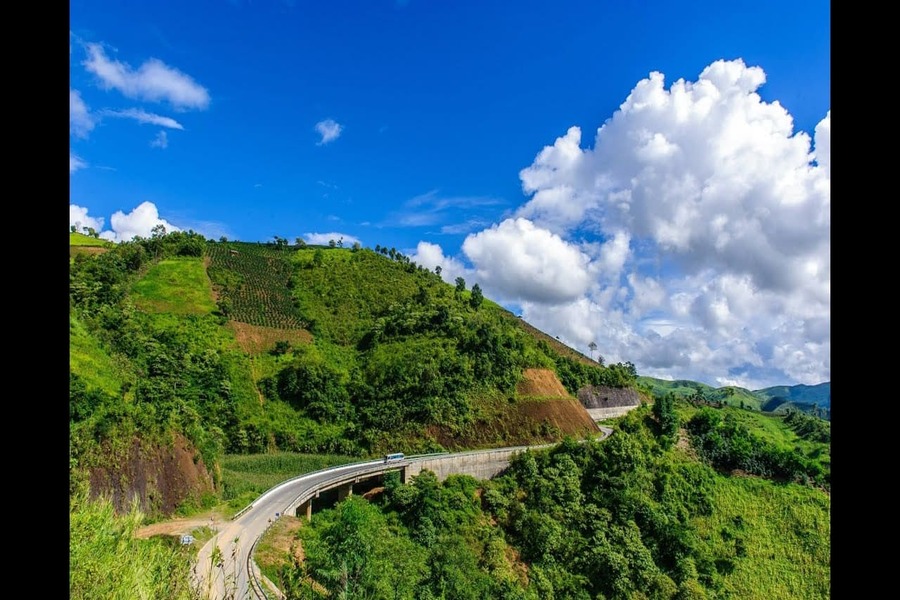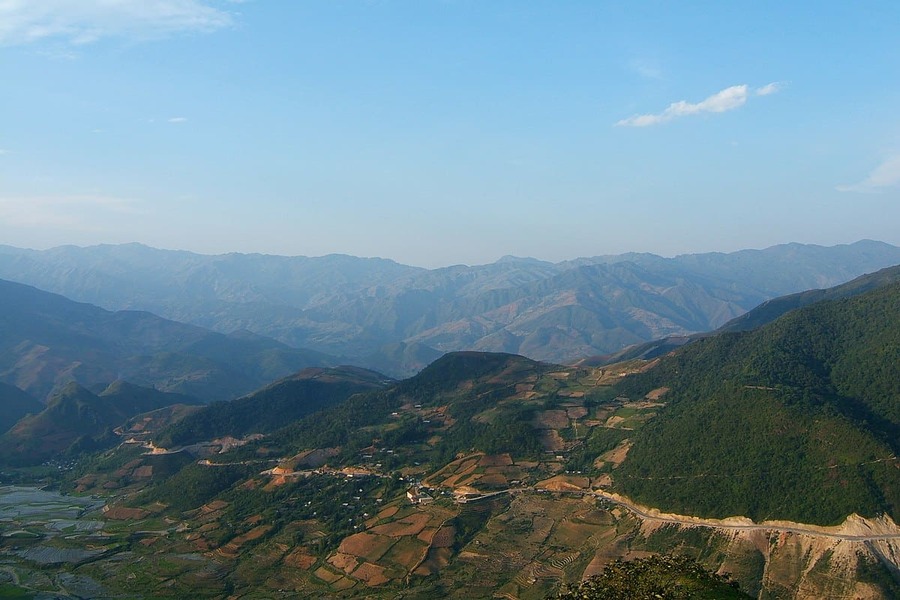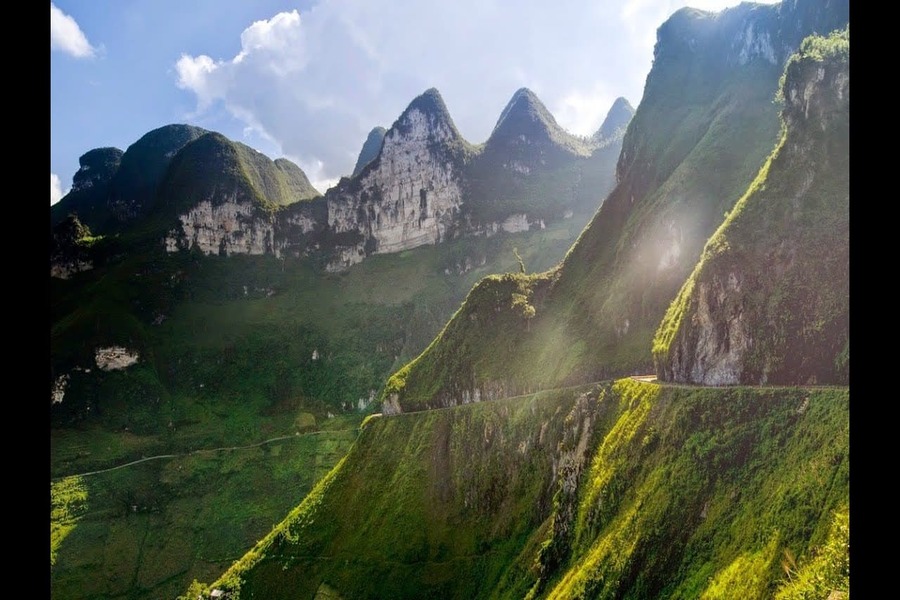Great Mountain Passes of Vietnam are not just feats of engineering – they are winding ribbons of road that cut through the majestic northern highlands, offering breathtaking views and unforgettable journeys. Revered as Northern Vietnam’s Four Great Mountain Passes, these iconic routes captivate travelers with their dramatic landscapes, thrilling curves, and the sense of freedom that only the open mountain road can bring. For those planning Vietnam, Cambodia & Laos tours, these mountain passes can add a truly unique and adventurous dimension to your itinerary. In this guide, we explore the four greatest mountain passes are Pha Din, O Quy Ho, Khau Pha and Ma Pi Leng.
Pha Din pass
Among the legendary passes in Vietnam’s northern mountainous region, Pha Din Pass stands out not only for its majestic landscape but also for its deep historical and cultural significance. Located between Son La and Đien Bien provinces, Pha Din is part of the renowned “Four Great Mountain Passes of Northern Vietnam,” drawing travelers who seek the thrill of high-altitude roads and the serenity of untouched highlands.

The name “Pha Din” originates from the Thai ethnic language, where “Pha” means sky and “Din” means earth – a fitting description for a route that climbs to over 1,600 meters above sea level. Spanning more than 30 kilometers, the pass winds dramatically through rugged cliffs, pine forests, and mist-laden valleys, often leaving travelers in awe of its vertical drops and sweeping vistas.
Driving or riding through Pha Din is an experience of constant contrasts. One moment, you’re enclosed by towering cliffs and swirling fog; the next, the view opens up to reveal rolling hills, terraced fields, and tiny villages nestled between green ridges. The road itself has undergone improvements in recent years, making it more accessible, yet it still retains the raw, adventurous charm that appeals to motorbike enthusiasts and photographers alike.
Pha Din Pass also holds an important place in Vietnamese history. During the First Indochina War, it served as a crucial supply route for the Vietnamese army heading toward the historic battle of Dien Bien Phu. The pass was known for its treacherous conditions, and many stories of perseverance and sacrifice are tied to this mountainous corridor.
Today, Pha Din is more than just a road – it’s a symbol of the resilient spirit of the northwest. Along the way, you’ll find scenic rest stops, small local cafés, and even a few viewing platforms where you can take in the full beauty of the landscape.
O Quy Ho mountain pass
O Quy Ho Pass stands as the longest and arguably the most awe-inspiring. Stretching over 50 kilometers across the Hoang Lien Son mountain range, this spectacular route connects Lao Cai and Lai Chau provinces, and lies near the base of Fansipan – the highest peak in Indochina. Its towering elevation, which reaches nearly 2,000 meters above sea level, makes O Quy Ho not only a dramatic road to drive but also a symbolic gateway to the sky.

Often referred to as the “Cloud Pass” due to the thick mist that frequently blankets the area, O Quy Ho enchants travelers with ever-changing weather and breathtaking views. On clear days, the pass reveals vast valleys, terraced rice fields, pine forests, and sharp mountain ridges that seem to stretch endlessly into the horizon. The journey through the pass is a favorite among motorbike riders, photographers, and adventurers drawn to its rugged beauty and the thrilling curves that challenge even seasoned drivers.
What sets O Quy Ho apart from the other Northern Vietnam’s four great passes is not only its length but also its diverse climate. One side of the pass – typically the Lao Cai side – is cooler and often shrouded in fog, while the Lai Chau side tends to be warmer and sunnier. This natural contrast adds another layer of intrigue to an already unforgettable ride.
Khau Pha mountain pass
Khau Pha Pass is often celebrated as the most mysterious and untamed. Located in Yen Bai province, this high-altitude pass stretches approximately 30 kilometers and winds its way through the rugged terrain of the Hoang Lien Son mountain range. At over 1,200 meters above sea level, Khau Pha is not the highest or the longest, but its wild beauty and dramatic curves make it one of the most unforgettable drives in the country.
The name “Khau Pha” means “Heaven’s Horn” in the language of local ethnic groups, a name that perfectly captures the surreal sensation of driving through clouds and mist with panoramic views of deep valleys and steep mountain cliffs. The pass is especially famous during the rice harvest season in September and October, when the golden terraced fields of Mu Cang Chai come alive with color. This spectacle draws photographers and adventure lovers from all over the world.

Khau Pha is a favorite among off-the-beaten-path travelers seeking an authentic connection with Vietnam’s ethnic cultures. Along the pass, you’ll encounter Hmong and Thai villages, each offering unique insights into traditional highland life. The journey itself, with its narrow bends and lack of guardrails, demands caution – but also rewards drivers with a sense of discovery and awe.
Unlike the more developed tourist routes, Khau Pha remains relatively untouched, preserving the raw essence of Vietnam’s northwest. As one of the Four Great Mountain Passes of Vietnam, it symbolizes the harmony between nature and human resilience.
Ma Pi Leng mountain pass
Nestled in the rugged highlands of Ha Giang province, this legendary mountain pass stretches about 20 kilometers along the Hanh Phuc (Happiness) Road, linking the remote towns of Dong Van and Meo Vac. Though it is the shortest of the four, Ma Pi Leng leaves an impression that far exceeds its length in Vietnam’s four great passes.

What truly sets Ma Pi Leng apart is its elevation and terrain – perched at over 1,500 meters above sea level, the pass offers jaw-dropping views of the Nho Que River snaking through deep gorges below. The road clings tightly to sheer limestone cliffs, creating thrilling vantage points that draw adventurers, photographers, and motorbike travelers year-round. Each bend reveals a new slice of natural grandeur, from towering peaks to lush valleys wrapped in morning mist.
Ma Pi Leng is also a place rich in ethnic culture. The surrounding area is inhabited by minority communities such as the Hmong, Dao, and Tay, whose hillside homes and rice terraces form part of the region’s unique charm. Visitors often enrich their experience by exploring local markets or staying in traditional homestays along the route.

0 Comment